Introduction
The investment process is primarily concerned with investors’ decisions about which products or securities to invest in and when to make the chosen investment. Investors, such as banks, angel investors, or venture capitalists, emphasize different criteria when deciding on investing (Miková et al., 2009; Nunez et al., 2014; Simic, 2015; Crick and Crick, 2018), which are typical for every investor “but are generally based on three aspects, namely: profitability, risk level, and liquidity” (Miková et al., 2009). According to Croce et al. (2014), investors often reject, already at the pre-review stage, those investment projects for which there is no apparent high growth potential as well as projects that do not contain innovation. We understand the term “innovation” equally, as is defined by the OECD „implementation of a new or significantly improved product (good or service), or process, a new marketing method, or a new organizational method in business practices “. Other authors such as Cumming and Zhang (2019) state that „investment in innovation can be a catalyst for economic growth worldwide “.
An important part of each innovation system is the so-called angel investors. They are individual investors using their equity to finance small and medium-sized enterprises with significant growth potential. They use the gap between financing business from their resources or from family members of the entrepreneur and financing through professional venture capital funds. This capital plays a key role in that, in addition to the necessary finances, the entrepreneur acquires an experienced partner in his business – a mentor, whose advice, experience and contacts can be as valuable at the beginning of business as the money itself. (podnikajte.sk, 2021). Investing by angel investors focuses mainly on projects involving technological innovation. One of the suitable areas for investment is the e-commerce sector, which has now become much more important (also because COVID19 pandemic). The current situation has supported the growth of the e-commerce market and the transfer of consumers to the online world. Therefore, this paper examines the fact whether the field of e-commerce in Slovakia is a suitable target for investors.
Literature Review
The field of electronic commerce and shopping (e-commerce) has been growing continuously for several years. Similarly, as in other areas of social life, the Covid-19 pandemic has accelerated this growth and brought clients even more into the online environment. A visually attractive website, e-shop, or user interface is common today, and in the increasing competition of Internet sales and online communication with customers, it is important to introduce new technological innovations.
The importance of investing in the e-commerce sector is also supported by the large number of published scientific and professional papers, from which we select:
Table 1: Selection from the review of the analyzed literature
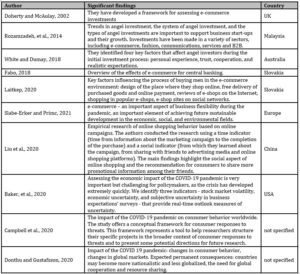
(Source: prepared by authors)
Characteristics of e-Commerce in Slovakia
The current situation in the researched areas (investment, e-commerce) in Slovakia is mapped by professional and community portals, from which we have selected the most relevant: P3 Logistic Parks, Forbes, Mergado, Crowdberry and Touchit.
Portal P3 Logistic Parks (2020) states that the current COVID19 pandemic has changed and continues to change many of the existing paradigms, both socially, economically, and technologically, which has a major impact on citizens’ work and shopping habits. The pandemic has accelerated the scale and pace of e-commerce adoption across Europe, in three main ways: accelerating the adoption of the Internet, accelerating the transition from physical to online shopping, and accelerating automation and cashless payments. At the same time, the interest in investing in startups has increased and investors are looking for opportunities to invest in growing companies. According to Forbes (2021), investments in areas such as cloud services, e-commerce, and green energy currently resonate.
In recent years, the Slovak online market has created a strong place on the map of European e-commerce. Slovakia, as a smaller Central European country, is already competing with many large European countries in the growth of e-commerce. The year 2019 brought online sales turnover over € 1.3 billion and the strong shopping year 2020 raised it to € 1.75 billion. (Mergado, 2020).
Analysts at Crowdberry (2020) also say that most opportunities for growth open up in sectors that benefit from the dynamics of e-commerce. In the world of alternative investments, the interest is concentrated on investments bringing innovations or improved customer and supply services. As a result of the COVID-19 pandemic, the transfer of customers to the online environment has increased several times. While in 2019 the e-commerce market share in Europe accounted for 12 percent of total retail sales, in 2020 it rose to 16.2 percent. In Slovakia, the size of the e-commerce market in 2019 was € 1,360 million, an increase of up to 94 percent compared to the previous four years. The share of e-commerce in total sales in Slovakia in 2020 was only 4.6 percent, but in the Czech Republic it reached 12.7 percent. For investors, therefore, investments in companies that run successful e-shops are an attractive segment.
Since the results published on Slovak portals are presented in a strongly aggregated form, we will examine Slovakia’s attractiveness from the point of view of investing in e-commerce by looking at the habits of customer behavior in online shopping, assessment of changes in this area due to the COVID19 pandemic, as well as the related estimate of the use of e-commerce in the future.
Research Framework and Methodology
The main goal of this paper was to examine whether the e-commerce sector in Slovakia is a suitable target for investors. We examine the development of the customer’s behavior habits by online shopping, with the focus on the identification of customer online shopping behavior patterns and how they were affected by the pandemic COVID19, as well as on the estimated use of e-commerce in the future.
We have established the following assumptions for the research:
- Men and women have different approaches to online shopping.
- Young people are more interested in online shopping than elder people.
- People with primary education are less engaged in online shopping than people with higher education.
- The approach of university students to online shopping is different in comparison to the approach of other respondents.
To verify the research assumptions, 4 research hypotheses were proposed, formulated as null (H0) and alternative hypothesis (H1):
1H0: The gender of respondents does not statistically significantly affect the approach to online shopping.
1H1: The gender of respondents statistically significantly affects the approach to online shopping.
2H0: The age of respondents does not statistically significantly affect the approach to online shopping.
2H1: The age of respondents statistically significantly affects the approach to online shopping.
3H0: Respondents’ education does not statistically significantly affect the approach to online shopping.
3H1: Respondents’ education statistically significantly affects the approach to online shopping.
4H0: The approach to online shopping of university students does not differ statistically significantly from the approach of other respondents.
4H1: The approach to online shopping of university students differs statistically significantly from the approach of other respondents.
The research consisted of 3 main stages (Fig. 1). In the first stage, we focused on the study of scientific and professional literature with a focus on investing in e-commerce. In the second stage were formulated research assumptions and research hypotheses. At the same time was created a research model (model of research indicators) to verify them. Stage 3 was a statistical verification of hypotheses and formulation of conclusions.
Standard methods of scientific work (analysis and comparison) were used in the study of the literature. The primary method was a questionnaire survey, which was conducted in the period from March 2021 to April 2021 on a sample of 646 respondents older than 18 years living in Slovakia. The questionnaire was created based on a research model and consisted (except for the entry of parameters) of 2 groups of questions focused on 2 areas of research, namely the online shopping behavior and changes in this area caused by the COVID19 pandemic, as well as the planned use of e-commerce in the future.
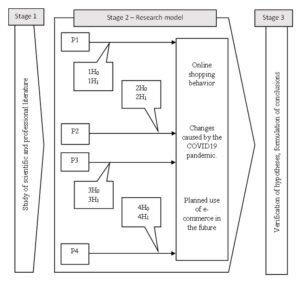
Fig 1. Research framework
(Source: prepared by authors)
Parameters of the research sample are presented together with the results of descriptive statistics in Table 2. Note: the codes of the relevant indicators and their values are given for further use in the verification in the PSPP software.
The research indicators were divided into two groups (Table 3 and 4). The first group consisted of indicators S1, …, S12, for which the respondents could choose any number of several offered answer options (nominal values). The second group (Z1, … Z10) consisted of indicators that were evaluated on a 5-point Likert scale from 0 to 4, where 0 corresponding to a minimum agreement and 4 – a maximum. Descriptive statistics methods and cross tables were used to evaluate the results. The hypotheses were verified by statistical methods and coefficients suitable for measuring the relationships between nominal, respectively dichotomous variables, namely: chi-square and Cramer´s V, and linear regression was used for the variables measured by the Likert scale (Hanák, 2016). Verification was performed by PSPP statistical software.
Other methods were:
- Cluster analysis (to identify similar or different groups of data). The cluster analysis was performed using the WEKA program (Hall et al., 2009), specifically the clustering method and the Simple K-means algorithm, which best corresponded to the format of the questionnaire variables,
- Synthesis (to formulate conclusions and recommendations).
Results and Discussion
This chapter presents the results of the questionnaire survey, including the research sample, the results of the evaluation of individual indicators according to the research model and the results of the verification of hypotheses, and the results of the cluster analysis.
Results of the Questionnaire Survey – Research Sample
The research sample was characterized based on gender (P1), age (P2), education (P3), and whether the respondent is a university student or not (P4). The structure of the research sample is detailed in Table 2. It consisted of more women (almost 61%) than men (more than 39%), the highest proportion was in the age category up to 25 years (74.92%) with secondary education (73.68%), while more than half were university students.
Table 2: Research sample
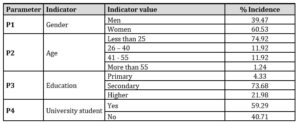
(Source: prepared by authors)
Results of the Evaluation of the Examined Indicators
The approach to online shopping was measured by two groups of indicators. Through the first group S1, …, S12, we found out the behavior of users on the Internet when they shop online, through the second group of indicators we found out the changes of behavior due to the COVID 19 (Z1, …, Z5) and the planned use of e-commerce in the future (Z6, …, Z10).
The results of the evaluation of the first group of indicators are shown in Table 3. Important percentage ratings are highlighted in bold.
Table 3: Results of the evaluation of the first group of indicators
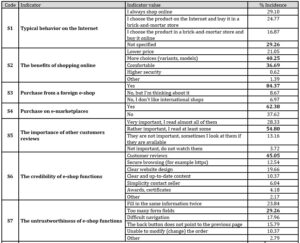
(Source: prepared by authors)
Based on the evaluation of the respondents’ answers, we can characterize the respondent’s behavior as follows: As their typical behavior, less than 30% of respondents stated exclusive shopping on the Internet. Most combine online shopping with shopping in brick-and-mortar stores (S1). At the same time, approximately 30% of respondents did not report the S1 indicator. Respondents consider the greatest advantage of online shopping to have more choices and comfortability (S2). Most of them – up to 84% shop in foreign e-shops (S3), approximately 62% in e-marketplaces (S4).
Respondents also assessed the quality of the website itself and the operation of the e-shop (S5, …, S11). For most of them, the reviews of other customers are important (S5, S6). The importance of “clear and up-to-date content” mentioned only 10% of respondents, but “clear website design” about 10% more.
Respondents marked the filling in the same information twice and too many form fields (more than 50%) among the most untrustworthy elements of the website. The most common reasons for leaving the website were mandatory account creation (47%) and too long/complicated checkout process (47%). However, more than 50% of respondents did not leave the site during the checkout process for these reasons. The preferred delivery method is by courier, directly to the place of residence (66%), and the preferred payment method is card payment. The first 5 most purchased online product categories are: clothing, IT/high tech, sport, books and hygiene.
The results of the evaluation of the second group of indicators are in Table 4, where the respondents’ opinions on changes in online shopping caused by the COVID19 pandemic are summarized. The variables Z1, Z3, and Z2 got the highest score; respondents spend more time on the Internet, especially on entertainment websites, and more often shop online and watch online health information than before. It is interesting to compare the evaluation of indicators Z1 and Z10, which both relate to the use of websites with entertaining content. While the current situation in this area was assessed by the respondents with the highest positive opinion (Z1, average 2.82), the expected use of these web pages is much lower (Z10, average 1.74).
Table 4: Descriptive statistics of the second group of researched indicators

(Source: prepared by authors)
Results of statistical verification of hypotheses
Statistical verification of the relationships between the nominal variables was performed using the coefficients Chi-square and Cramer´s V. We present only statistically significant relationships (Table 5 and Table 6). A total of 11 variables S1, …, S11, and 10 variables Z1, … Z10 were tested according to 4 parameters P1, …, P4.
Differences according to parameter P1 (gender) were demonstrated only for 4 indicators from the first group, and 4 indicators from the second group, therefore we accept hypothesis 1H0 and reject hypothesis 1H1. Therefore, the gender of the respondents does not statistically significantly affect the approach to online shopping.
According to the parameter P2 (age), 7 of 12 relationships from the first group and 6 of 10 relationships from the second group were statistically significant, therefore we can accept hypothesis 2H1 and reject hypothesis 2H0. It was proven that the age of the respondents statistically significantly affects their approach to online shopping.
The difference according to parameter P3 (education) could not be demonstrated, because only one relationship from the first group and four relationships from the second group of research indicators were statistically significant. For this reason, we accept hypothesis 3H0 and reject hypothesis 3H1. It was not possible to show that the education of respondents statistically significantly affects their approach to online shopping.
It is similar in the case of parameter P4 (university student), where statistical significance was confirmed in the case of 4 relationships from the first group and 2 relationships from the second group of research indicators. We accept hypothesis 4H0 and reject hypothesis 4H1. It has not been demonstrated that the fact that respondents are or are not university students significantly affects access to online shopping.
Table 5: Results of statistical verification of differences of the first group of indicators according to
P1, P2, P3, and P4
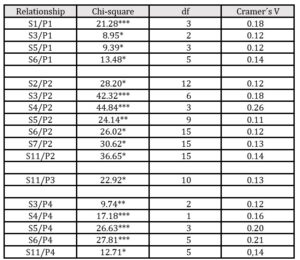
*p<0.05. **p<0.01. ***p<0.001
(Source: prepared by authors)
Table 6: Results of statistical verification of differences of the second group of indicators according to
P1, P2, P3, and P4
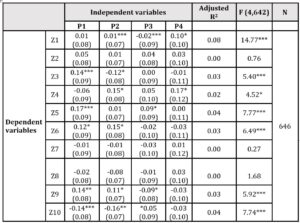
*p<0.05. **p<0.01. ***p<0.001
(Source: prepared by authors)
Results of cluster analysis
The results of the cluster analysis are shown in Table 7. The highest and lowest average values of the indicators, as well as the overall averages in individual clusters, are highlighted in bold.
Table 7: The results of the cluster analysis
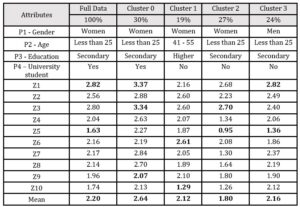
(Source: prepared by authors)
We used the Simple K-means algorithm by solving the cluster analysis (which groups related values into individual clusters and at the same time differs from other clusters). We gradually changed the number of clusters from 2 to 5 and recorded the resulting evaluations of indicators Z1, …, Z10. The even distribution of the research sample was for 4 clusters, so we chose these results for reporting. The Full Data column shows the average values of the whole examined sample (all Clusters); the grouped values of individual clusters are identified using the SimpleKMeans algorithm in the other columns.
The overall average results of the cluster analysis correspond to the results obtained by the previous methods, but some interesting findings were identified when comparing the individual clusters.
Cluster 0 represents 30% of women under the age of 25 with secondary education who are university students. Respondents from this cluster rated indicator Z1 – I surf more and spend more time on entertainment websites and Z3 – I shop online more often than before the highest and at least the indicator Z9 – I will travel more locally. All indicators were rated above average, as evidenced by the highest average (2.64).
Cluster 1 groups 19% of college educated women between the ages of 41 and 55, who rated the Z6 indicator – Next summer I will spend my vacation in Slovakia and I will not travel abroad the highest and lowest Z10 indicator – I will spend more time on electronic services with entertainment content. These assessments reflect the priorities of women of this age group, especially in relation to online entertainment.
Cluster 2 consists of 27% of women under the age of 25 with a secondary education who are not university students. Respondents in this cluster achieved the lowest average when evaluating their behavior on the Internet due to the COVID 19 pandemic. The Z3 indicator – I shop online more often than before was rated the highest, lowest the Z5 indicator – In my online purchases, I focus on basic needs such as food, drugstore, … Overall, we can say that the respondents grouped in cluster 2 do not attach much importance to online shopping activities.
Cluster 3 makes up 24% of high school-educated men under the age of 25 who have the highest score of Z1 indicator – I surf more and spend more time on entertainment websites and lowest the Z5 indicator – In my online purchases, I focus on basic needs such as food, drugstore, …
Cluster analysis confirms that 54% of young people with secondary education rated the highest online shopping behavior indicators (cluster 0 and cluster 3). This fact creates a good precondition for the further development of electronic commerce in Slovakia and also that e-commerce can be a proper object for investment.
Conclusion
The main goal of this paper was to examine whether the e-commerce sector in Slovakia is a suitable target for investors. We focused on the identification of customer behavior patterns during online shopping, to assess whether something has changed due to the pandemic COVID19 in this area, as well as on the related estimated use of e-commerce in the future. These findings should serve as a predictor of future development in the field of online shopping, which directly affects the attractiveness of e-commerce companies.
Customer behavior in Slovakia is accommodating to the use of e-commerce. Most respondents, up to 75% of young people under the age of 25, either shop online or combine online shopping with brick-and-mortar shopping and they are aware of the benefits of online shopping.
Respondents who participated in the research consider the other customers’ reviews to be very important when deciding on the choice of e-shop or specific goods. Customers evaluate the quality of e-shop websites based on the credibility and untrustworthiness of their functions, appreciate the clear design of the website, clear and up-to-date content, intuitive navigation, and layout of controls. They are most bothered by filling in information multiple times and too many form fields. They are especially critical of those elements of e-shops that make shopping comfort uncomfortable. As many as 29.1% of respondents state that they shop exclusively on the Internet.
Due to the COVID19 pandemic, which restricted the free movement of citizens, respondents spent more time online. Most often they were engaged in surfing on the Internet, online entertainment through websites, online shopping and searching and tracking health information. At the same time, most of them plan to increase their online activities in the future.
These facts are promising for investing in e-commerce in Slovakia and they are in line with global trends. The limiting factor of our research was the research sample, which consisted mainly of respondents under 25 years of age. It would be appropriate to carry out such research with respondents evenly distributed across age groups. In terms of e-commerce, attractiveness is very positive, that the younger generation is more inclined to online purchases than brick-and-mortar purchases.
Acknowledgments
This research was supported by a grant from the Slovak Ministry of Education Science, Research and Sport, VEGA 1/0767/21: Modelling the decision-making of investors assessing business proposals.
References
- Baker, S. R., Bloom, N., Davis, S. J., Terry, S. J. (2020). ‘Covid-induced economic uncertainty (No. w26983)’. National Bureau of Economic Research. http://www.nber.org/papers/w26983
- Campbell, M. C., Inman, J. J., Kirmani, A., & Price, L. L. (2020). In times of trouble: A framework for understanding consumers’ responses to threats. Journal of consumer research, 47(3), 311-326.
- Crick, J. M., Crick, D. (2018). ‘Angel investors’ predictive and control funding criteria: the importance of evolving business models’, Journal of Research in Marketing and Entrepreneurship, 20 (1), 34-56.
- Croce, A., Tenca, F., Ughetto, E. (2017). ‘How business angel groups work: Rejection criteria in investment evaluation’, International Small Business Journal, 35(4), 405-426.
- (2020). ‘Pandémia urýchlila rast niektorých segmentov’. [Online], [Retrieved August 25, 2021], https://www.crowdberry.eu/news/pandemia-urychlila-rast-niektorych-segmentov.
- Cumming, D., Zhang, M. (2019). ‘Angel investors around the world’, Journal of International Business Studies, 50(5), 692-719.
- Doherty, N. F., McAulay, L. (2002). ‘Towards the formulation of a comprehensive framework for the evaluation of investments in sell-side e-commerce’, Evaluation and Program Planning, 25(2), 159-165.
- Donthu, N., & Gustafsson, A. (2020). Effects of COVID-19 on business and research. Journal of business research, 117, 284-289.
- Fabo, B. (2018). ‘Implications of e-commerce for central banking: A review’, Biatec, 26(4), 27-30.
- (2021). ‘Investujete? Podľa odborníkov by ste mali začať. Aký spôsob zvoliť podľa výšky príjmu? ‘. [Online], [Retrieved September 12, 2021], https://www.forbes.sk/investujte-s-nami-aj-vy-odbornici-radia-aky-sposob-je-vhodny-podla-vysky-vasho-prijmu/.
- Hall, M., Frank, E., Holmes, G., Pfahringer, B., Reutemann, P., Witten, I. H. (2009). ‘The WEKA Data Mining Software: An Update’, SIGKDD Explorations, 11(1), 10–18.
- Hanák, R. (2016). ‘Data analysis for social sciences’. Bratislava, Slovak Republic: Publisher EKONÓM, 87-88.
- Laitkep, D. (2020). ‘Kľúčové faktory ovplyvňujúce proces nákupu mužov v prostredí e-commerce’. Pošta, telekomunikácie a elektronický obchod, 15(1), 50-58.
- Liu, Q., Zhang, X., Huang, S., Zhang, L., & Zhao, Y. (2020). Exploring consumers’ buying behavior in a large online promotion activity: The role of psychological distance and involvement. Journal of theoretical and applied electronic commerce research, 15(1), 66-80.
- (2020). ‘Veľký prehľad slovenskej e-commerce’. [Online], [Retrieved September 12, 2021], https://www.mergado.sk/blog/prehlad_SK_ecomm.
- Miková, O., Bikár, M., Kmeťko, M. (2009). ‘Finančné investície’. Bratislava: Publishing House EKONÓM.
- Nunes, J. C., Félix, E. G. S., Pires, C. P. (2014). ‘Which criteria matter most in the evaluation of venture capital investments? ‘ Journal of Small Business and Enterprise Development, 21(3), 505-527.
- (2015). ‘The OECD Innovation Strategy ̶ 2015 revision’. Internal document. Paris: OECD. [Online], [Retrieved September 15, 2021], https://www.oecd.org/innovation/innovation-imperative.htm.
- P3 Logistic Parks. (2020). ‘Je COVID-19 zlomovým bodom pre e-commerce? ‘. [Online], [Retrieved September 15, 2021], https://www.p3parks.com/sk/novinky/vizia/je-COVID-19-zlomovym-bodom-pre-e-commerce.
- sk. (2021). ‘Podnikateľskí anjeli a siete podnikateľských anjelov’. [Online], [Retrieved September 15, 2021], https://www.podnikajte.sk/investor/podnikatelski-anejli-a-ich-siete.
- Rostamzadeh, R., Ismail, K., Zavadskas, E. K. (2014). ‘Multi criteria decision making for assisting business angels in investments’, Technological and Economic Development of Economy, 20(4), 696-720.
- Simic, M. (2015). ‘Investment criteria set by venture capitalists’. Ekonomski Vjesnik/Econviews: Review of Contemporary Business, Entrepreneurship And Economic Issues, 28(2), 457-479.
- Slabe-Erker, R., Primc, K. (2021). ‘ICT-enabled organisational flexibility to support sustainable growth in Europe amidst a pandemic’, Journal of Science and Technology Policy Management, 2053-4620.
- White, B. A., Dumay, J. (2020). ‘The angel investment decision: insights from Australian business angels’. Accounting & Finance, 60(3), 3133-3162.










